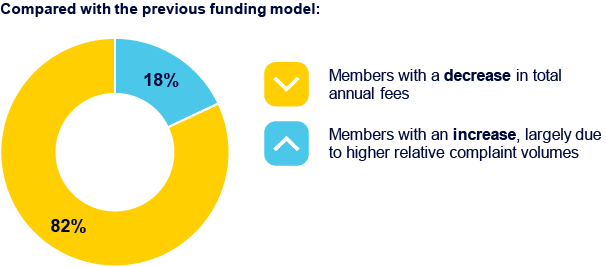AFCA’s largest users contribute most under the new funding model. For Superannuation this means that fees are distributed toward those who use AFCA’s services most frequently.
The majority of Superannuation members (~82%) will experience reduced total annual fees under the new funding model. 1
25% will only pay the annual registration fee
The new funding model recalibrates funding toward those who use AFCA’s services most frequently.

In the superannuation industry, 49% of AFCA’s revenue from superannuation under the new model will be recovered from very large businesses who represent 10% of all super members and 49% of all super complaints received by AFCA.
Note: All figures are estimates only, based on FY 21 data and excluding ACRs. These estimates are based on a historical cut of complaints data and are not a definitive statement of what fees a member will pay in the future.
Transition
The superannuation levy was not attributed to, or related to, complaint closures in any way. It was a levy that was paid by superannuation trustees to access AFCA’s services for a given year and was based on assets under management.
Cases closed after 1 July 2022 therefore are not covered by the levy for the previous year. They will be paid for under the funding structure applicable at the time – which is the new funding structure.
Under the new funding model, replacing the levy with a truly user-pays structure ensures that members with low or no complaints see a significant reduction in what they pay, while heavy users contribute accordingly.
If the new funding model were not to be implemented, superannuation trustee members would have to pay a new levy at the start of the financial year. In that case, trustees paying the levy according to their size but with low complaint volumes would continue to subsidise other members.
Overall, 82 per cent of super trustee members will see a reduction in their total cost, under the new model, with one in four paying only the annual registration fee.
